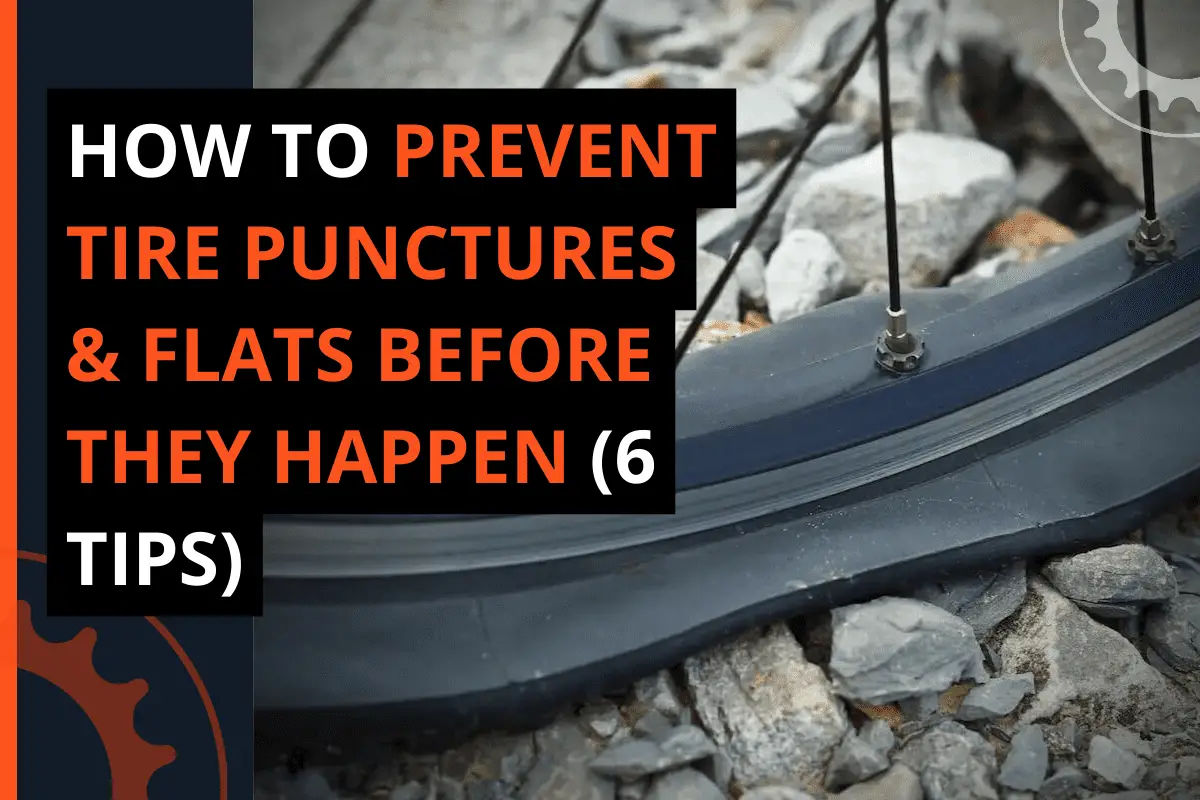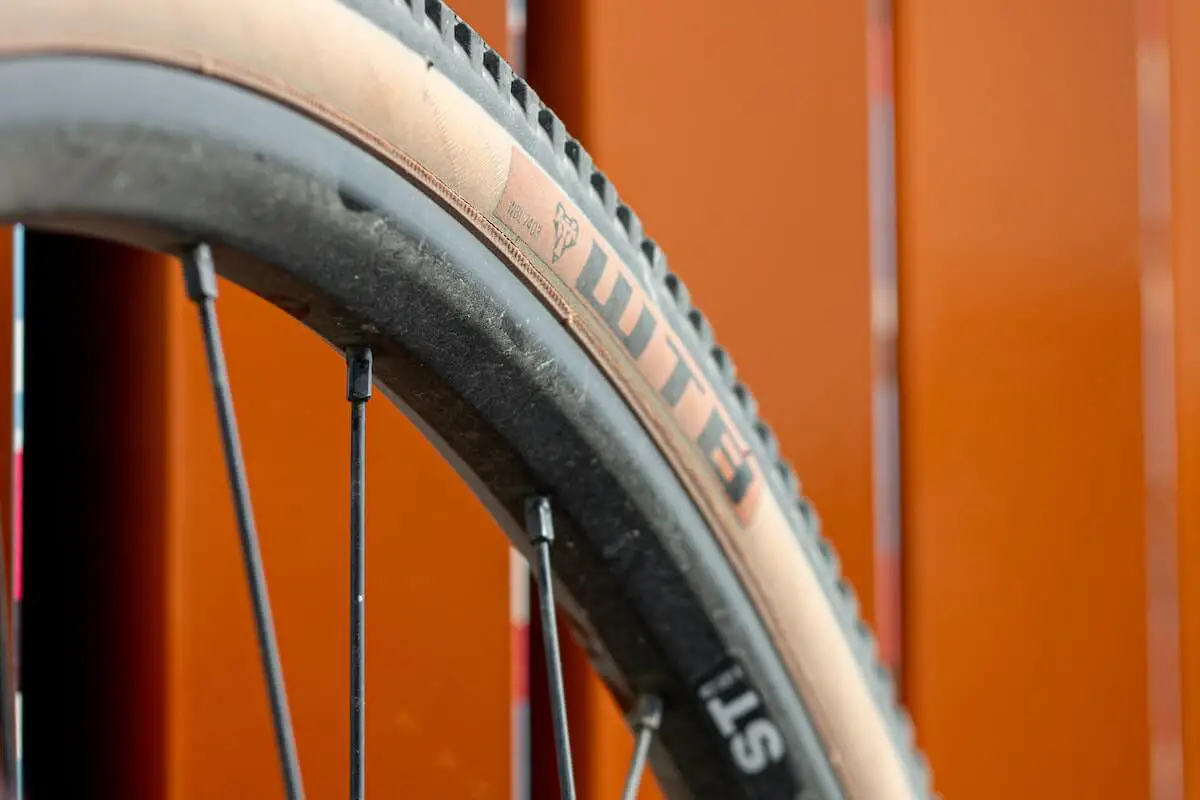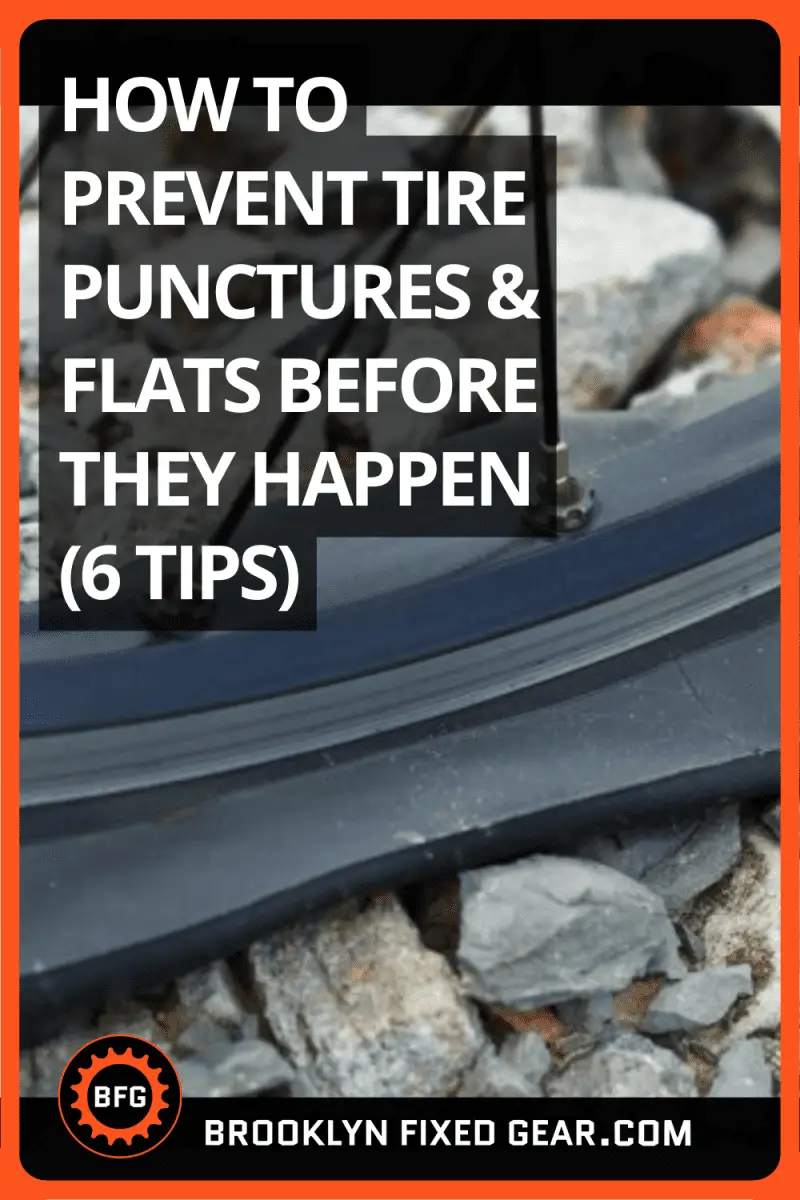There’s no greater joy than riding a bike. But there’s no greater pain than getting a flat tire. Getting a flat can be a nightmare, especially if you’re far from home or a bike shop. And even if there is a bike shop nearby, there might be a waiting list. So, how can you prevent tire punctures on a bike?
You may avoid tire punctures by using the appropriate bike and tires for the terrain you’ll be riding on. Avoid potholes and other obstructions on your trip if possible. Finally, keep an eye out for sharp items on the road, such as shattered glass.
But there’s a lot more to it than that. So, in this article, you will learn how to prevent tire punctures and flats so you can ride farther without fear of getting stranded with a flat.
Editor’s note: This article was updated on June 22, 2022, to include additional information regarding tire punctures.
Before learning about tire punctures, let’s first understand what a tire puncture is.
What is a tire puncture?
A tire puncture is a sudden instance where the integrity of your tire diminishes, causing air to leak out. This can happen suddenly or slowly over time.

All cyclists must deal with punctures eventually. If you commute by bicycle, punctures may be very irritating since they can create lengthy delays.
Cyclists in a city may be lucky enough to find a bike shop that can fix the flat right away, but there may be a waiting list.
State Bicycle Co. Black Label 6061

State Bicycle Co. Black Label 6061
What are the most common reasons for flat tires?
Some of the most prevalent causes of a flat tire are:
- Sharp objects puncture.
- The valve stem has failed or been damaged.
- The tire has been rubbed or torn.
- Overinflated tires (blowouts).
- Hazards on the road (potholes, debris)
- Uninspected damage.
- Rim damage (tubeless tires).
- Inner Tube Squeezing.
- Slow leakage.
- Pinch Flat.
How can I prevent tire punctures and flats?
Preventing flats may seem like it’s all up to chance. Of course, you could just avoid riding over glass or sharp objects, but as you are aware, this isn’t easy in many places.
But there are a lot of things we can do to prevent them. Below are six tips on avoiding punctures and flat tires before they happen.
Make sure your tires are fully inflated to spec

Pinch flats occur when you ride into anything that makes a sudden impact, such as a rock, railroad track, or the edge of a pothole. The collision compresses the tire so much that the tube becomes trapped between the rim’s edges.
This results in two little holes on the rim side of the tube. Because they resemble fang marks, pinch flats are sometimes called snakebite flats.
Most pinch flats are caused by a combination of three factors: insufficient air pressure, inflation pressure, too thin tires, and/or improper riding style.
Thus, to avoid pinch flats, fully inflate your tires to the manufacturer’s specifications, monitor your air pressure, and stop slamming your underinflated tires onto the curb. Of course, we run into curbs and other things we shouldn’t from time to time, but if you do it with underfilled tires, you might just get a flat. So make sure that you inflate your tires properly.
Check your rim tape
Rim tape is a protective film that fits between the inner tube and the rim, hiding the sharp edges of the spoke holes. It is often made of plastic or rubber. These sharp edges are frequently the unseen culprits in puncturing your inner tube.
Check that the rim tape covers all spoke holes after removing your tires and tubes since the rim tape may have ripped or moved to the side. I usually advocate investing in high-quality rim tape to avoid this problem.
Buy puncture-resistant tires
Consider getting tires with extra protection to make it less likely to get a hole. Gator skins are a great option. They are quite effective at lowering the possibility of a puncture. These tires have a layer of reinforced rubber that makes them very strong and resistant to punctures.
Check out some of the puncture-resistant tires below. We also have an entire blog post dedicated to helping you choose an inner tube for your fixed gear bike if you need some help deciding.
[azonpress template=”grid” asin=”B01JN4YEDW,B0843HG3RR,B08DD4MXQ8″ ]Consider using slime-filled innertubes
Another technique to avoid punctures is to use slime-filled inner tubes or self-healing inner tubes. When slime-filled tires get a puncture, the slime quickly moves to self-seal the hole.
Slime-filled tubes are available pre-filled, or you may buy inner tubes with detachable valve cores that you can fill yourself.One of the drawbacks of slime-filled inner tubes is that they add some weight, although not much. You won’t notice it when commuting or doing leisure activities.
It’s important to note that liquid tire sealant is known to damage rims, which may be expensive to repair. Furthermore, no tire sealant is a long-term solution. In fact, many repair shops won’t fix a flat tire with a chemical sealant on it, so you may need to buy a new tire to replace your flat.
You should not use slime on Kenda tires because they are cotton-lined, and cotton rots when wet from slime.
If none is a concern, and you just want to avoid punctures when far from home, consider these slimy options below.
[azonpress template=”grid” asin=”B000ENMLFK,B000ENSRS0,B07H9G8P5V”]
Use protection tape
Another option is to get puncture-resistant tape and wrap it over the inner tire. This is meant to function as a puncture-resistant belt.
Try solid tires
Solid tires have become increasingly popular. A breakthrough technique has enabled the production of lightweight tires that match the weight of a tire and inner tube. You will never have a puncture with these new solid tires since they are 100% puncture-resistant.
An obvious drawback is that they’re heavier, which kind of goes against the whole lightweight fixie thing we love so much. But hey, it is an option.
Can you cycle with a puncture?
Do not ride on punctured tires. A punctured tire can damage the tire, inner tube, and rim. A flat tire may come off the rim, causing a crash. Instead, bring your bike to a nearby bike shop for repairs if you get a puncture.
Are there bike tires that never go flat?
There are airless bike tires that will not run flat, but many of them have huge holes that let in debris that must be cleaned up afterward. Others are constructed of foam, which provides less grip.
The SMART Tire Company’s airless tires, on the other hand, are constructed of metal, specifically a NASA-developed alloy incorporating nickel and titanium known as NiTinol. Riding on metal tires may seem terrible, but this alloy has unique qualities that guarantee a smooth ride without the risk of a flat.
How to replace an inner tube if you get a puncture
If worst comes to worst, you will need to know how to replace your inner tube. Then, learn to disassemble and reassemble your bike’s wheels. It’s not as complicated as it seems, and many YouTube videos explain each stage of the process.
Removing the front and back wheels on a single-speed or fixed-wheel bike is significantly easier than on a road bike with a cassette and derailleur. All you really need is an adjustable spanner for the wheel nuts (or nothing at all if you have quick-release wheels), a pump, and some tire levers.
Need some help? Check out this video showing how to remove your fixed gear tires.
Frequently Asked Questions (FAQ)
Below are some of the most commonly asked questions about preventing tire punctures.
Why does my bike wheel keep getting punctures?
Punctures are typically produced by a tiny, sharp item penetrating through the rubber and piercing the inner tube (flint, glass, thorns). Often, the object stays stuck in the tire. If you don’t find it and take it out, the same tiny bugger will quickly destroy the inner tube when you replace it.
Are bike tire liners worth it?
Liners are popular and effective, but they add 6 oz. or more to the weight of your tires, which increases rolling resistance substantially. On the other hand, liners may be well worth the weight if you live in an area with a lot of thorns or road debris.
How can you reduce the risk of punctures?
Examine and replace your tires and rims regularly. Never fix a ruptured inner tube; instead, replace it.
Can you get puncture-proof inner tubes?
Yes, you can buy puncture-resistant inner tubes. There are several possibilities available, and the best way to find the appropriate one for you is to experiment with them. Some solutions are to use a heat-sealed inner tube, a liner for reinforcement, or a bladder with a lining that can’t be punctured.
Why do I keep getting holes in my tires?
Rubber in tires may fracture when it deteriorates due to age, exposure to the environment, or a combination of the two. Because of this, it can be hard to find and fix problems with the rubber in your tires, which can lead to slow leaks, flats, and even blowouts.
How do I protect my inner tube?
Here are a few things you can do to protect your inner tube from becoming damaged or even ruined. Keep your inner tubes in a cool, dry location away from direct sunlight. Examine your inner tube for any damage. Before using your inner tube, always check the inflation pressure to ensure it is at the right level. Overinflating your tube can cause damage and loss of air pressure, causing it to explode.
How do you handle a bike puncture?
This is a frequently asked question among cyclists, and the answer varies based on the type of puncture (and cyclist). If you have a flat tire, you should replace the inner tube as quickly as possible.
Can a bike tire go flat without a hole?
Yes. This happens when the tube has a very small damage. To ensure that the issue is with the inner tube, listen carefully to the tube. Listen for a hissing sound.
Is it worth patching a bike tube?
Although some may argue otherwise, sometimes it is not worth repairing a tube unless you have a replacement tube available. Patch kits, on the other hand, are so small and light that there’s no excuse not to carry one unless you’re counting grams. It’ll be useful if you have a spare tube and two flats.
Conclusion
Getting a puncture is never fun, but if you can employ some of these tips, you just might avoid tire punctures in the first place.
This article covered what tire punctures are and how to prevent them. Here are some key takeaways:
Key takeaways
- Make sure your tires are fully inflated to the manufacturer’s specifications.
- Check your rim tape.
- Consider puncture-resistant tires.
- Consider using slime-filled innertubes.
- Use protection tape
- Consider solid tires.
So, do you have any tips you’d like to add to this list? Let us know in the comments below (we read and reply to every comment). If you found this article helpful, check out our full blog for more tips and tricks on everything fixie. Thanks for reading, and stay fixed.
Helpful Resources
- Articles about fixed gear and single-speed cycling and equipment
- Fixed-gear bicycle – Wikipedia
- How to Fix a Bicycle Tire Puncture
















